Then & Now – Main at Mission Inn
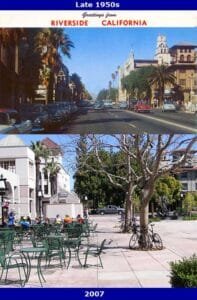
Before there was a Main Street Pedestrian Mall in downtown Riverside there was, well, an actual Main Street, with actual cars — and curbside parking.
Seen here in photos approximately 50 years apart is a view of Main Street looking north toward Mission Inn Avenue (formerly Seventh Street) from near University Avenue (formerly Eighth Street). On the far right is the historic Mission Inn and on the far left, with its pyramid-shaped, red-tiled roof (as seen in lower photo), is the Loring Building, which was built in 1890 and is one of downtown’s oldest, significant buildings still standing. Today, the former asphalt covered road has since been replaced with concrete and pedestrian-oriented landscaping.
Obviously, the scene has changed dramatically. But how and why? (To fully appreciate the change, check out the Flash overlay.)
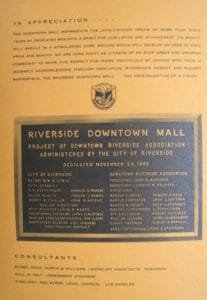
Following the 1956 opening of the nearby Riverside Plaza, downtown shopping began a slow but steady decline. In response, city leaders soon started working at remaking the city’s civic center. Plans included a landscaped pedestrian mall with spruced-up storefronts. Eventually, it was envisioned the mall would be anchored by what officials hoped would be a new city hall, a convention center / hotel and a performing arts center. (Only city hall and the convention center / hotel would come to fruition.)
In late 1965, the city settled upon an initial plan and work began in May of 1966 at tearing out Main Street between Sixth and Tenth streets. On November 23, 1966, the mall was officially dedicated and open for business. However, with its opening coinciding with America’s growing appetite for suburban shopping centers, the pedestrian mall got off to a rocky start.
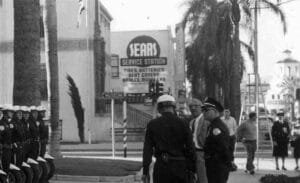
One major retailer (Sears) had already relocated to a new larger store on Arlington Avenue (in 1964) while two others (Montgomery Ward, JCPenney) would eventually follow suit in leaving downtown. The flight of retail only got worse with the 1970 opening of Riverside’s Tyler Mall (now Galleria at Tyler), which was double the size of the earlier Riverside Plaza and — more importantly at the time — it was enclosed.
Although the loss of the major retailers was significant, the pedestrian mall’s plight began stabilizing in the mid-1970s with the opening of the new city hall and convention center (anchoring opposite ends of the mall) as well as the 11-story Security Pacific National Bank building, which replaced some aging storefronts near the mall’s center on the west side of Main Street between Mission Inn and University avenues (formerly Seventh and Eighth streets). But as in the rest of America, the love affair with large enclosed shopping centers — and free easy parking — continued to erode the retail market in downtown Riverside.
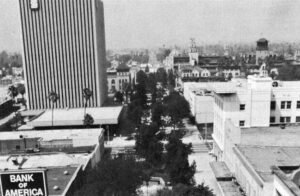
By the early 1980s, storefronts along the pedestrian mall consisted mostly of small local shops and a few antique stores plus various empty spaces. The slow decline of the Mission Inn, which had transformed from a once-opulent hotel into rental/student apartments, certainly did not help. For a while, it appeared both the Mission Inn and the pedestrian mall’s future were in doubt. Fortunately, both were spared from the wrecking ball.
One major development during this period was the 6-story Mission Square office building, which, in 1984, replaced another block of storefronts on the west side of Main Street between Ninth and University.
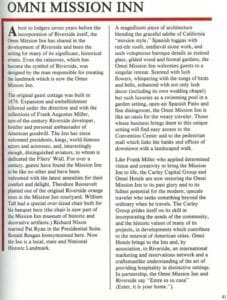
In 1988, however, things began looking up as a refurbished Mission Inn hotel was set to reopen. Renovated over 3 years to the tune of $30 million (which would eventually approach $50 million), the newly christened Omni Mission Inn was seen by civic officials as an important catalyst for reviving the floundering pedestrian mall. Yet, just weeks before its official grand opening, the Inn’s owner — Carley Capital Group — went bankrupt, forcing a takeover of the Inn by Chemical Bank of New York. The bankruptcy dealt a serious blow to both the mall and downtown in general. Moreover, it would be another 4 years before the Mission Inn — sans Omni — fully reopened.
Another significant event was the 1992 merger of Security Pacific National Bank into Bank of America, which saw the mall lose one of its primary anchors (Security Pacific). Subsequent plans for re-using the bank’s 11-story office building included an option for reopening parts of the pedestrian mall to limited traffic. Fortunately, a second event later that year — the purchase and reopening of the Mission Inn by local businessman Duane Roberts — helped keep the pedestrian mall intact and free of cars.
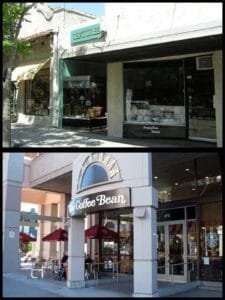
Today, the downtown pedestrian mall stretches over several blocks from Tenth to Sixth streets and remains one of California’s few remaining pedestrian malls from its time period. Although it has taken 40 years to arrive at where it is today — and indeed, a few rough spots remain — thankfully, most residents simply could not imagine it reverting back to just another traffic-clogged street. In fact, the pedestrian mall is about to undergo a face-lift — its first major rehab since being built in 1966.
Since the December 1992 reopening of the Mission Inn, the pedestrian mall has steadily picked up steam. The former Security Pacific Bank building has become a collection of offices — mostly for the state of California — while small independent shops throughout the mall coexist alongside a mixture of banks, eateries, service-related businesses, and cultural arts establishments.
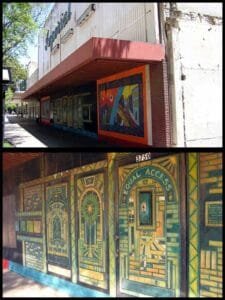
Recently, the mall has seen an influx of higher-end establishments such as Renuance Aesthetic Care and eateries Trilussa, Omakase and Coffee Bean & Tea Leaf. The most surprising empty spot remains the long-shuttered Imperial Hardware building, which in a strange twist has actually added a bit of flavor to the mall on account of its colorful art and mid-century facade, both seemingly frozen in time.
The one item still missing is a national retailer or major bookstore, which is likely to change within the next few years as the city’s plans for 500-plus condos and lofts begin taking shape (see: m’ sole and Fox Plaza). Our hope is that any potential influx of national chains, which could greatly increase out-of-area foot traffic, does so not at the expense of too many of the unique local shops — a few of which have survived a number of lean years.
Indeed, the recent surge in activity, the upcoming face-lift, the soon-to-be Culver Center for the Arts, and the planned residential/office development nearby promises to solidify the mall as downtown’s cultural and civic plaza. Without a doubt, the pedestrian mall is a unique gem that Riverside is fortunate to have.
(2025 Update: In March 2008, a year-long, two-phase makeover of the 1966-era pedestrian mall began. With the notable exception of the City Hall clock tower and fountain, the refurbishing project completely erased most of the original 1960s designs. Today, the four-block mall remains closed to traffic. However, the previously closed-off Ninth Street through the mall adjacent to City Hall was reopened as part of the 2008/2009 update and makeover.)
P.S. — For those curious, the back of the 1950s postcard, which incidentally misidentifies the intersection as Seventh at Orange (as opposed to Main at Seventh) reads as follows:
RIVERSIDE, CALIFORNIA – Seventh Street near Orange. This is a city typical of California at its best. Its tree-lined streets, Mission architecture, groves of fragrant orange trees and its atmosphere of hospitality never fail to impress the visitor.
Related
- Photo Gallery: Riverside — Pedestrian Mall: 1966-2008
- Flash: Main at Mission Inn: 1950s – 2007
- RaincrossSquare.com – Moving dirt a m’ sole (March 2007) | Then & Now – Main at Ninth (May 2006)
Update
Though it has had some lean times, luckily Riverside’s pedestrian mall did not suffer the fate of this one in St. Louis, which opened in 1977: Urban Review St. Louis: 14th Street Pedestrian Mall, Thirty Years Ago Today (March 2007)
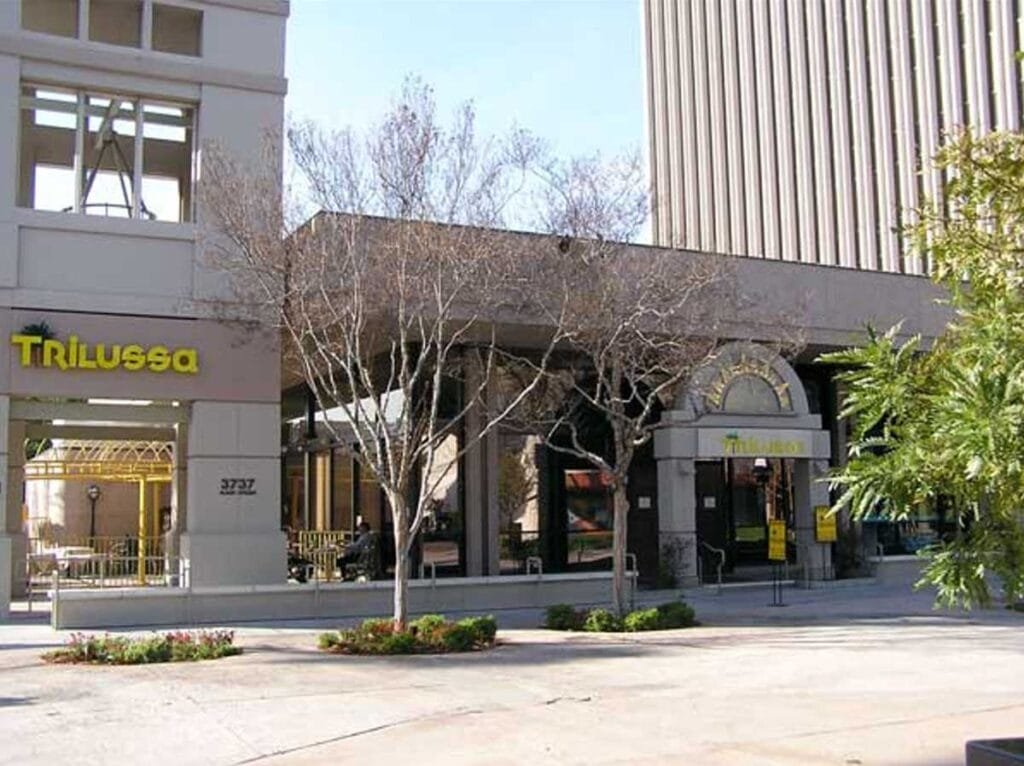
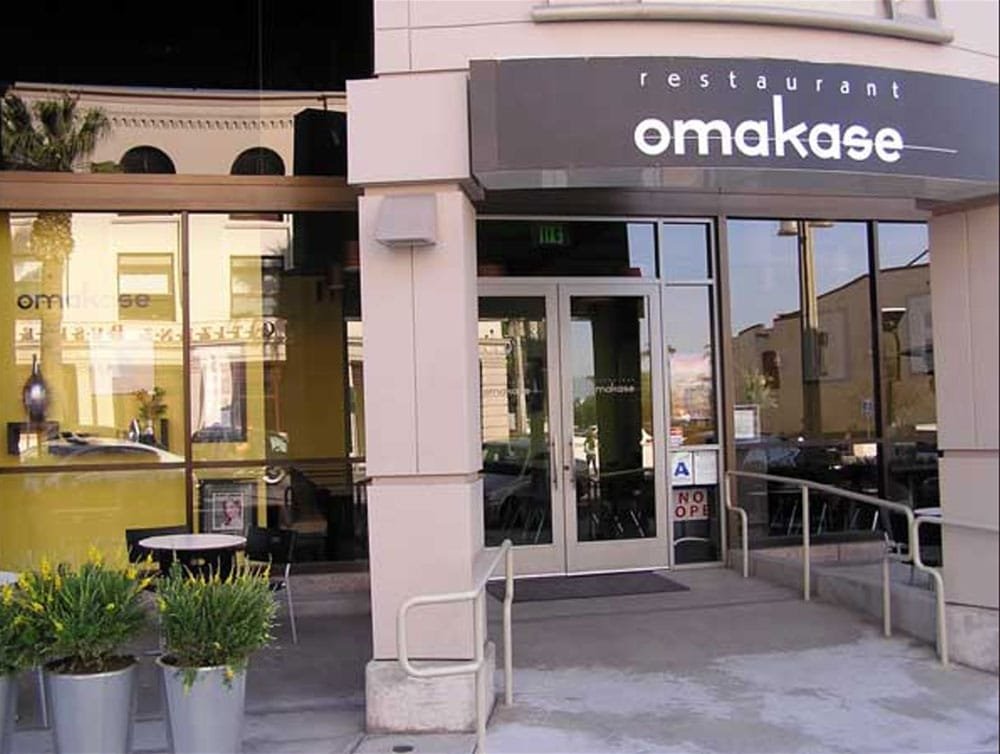
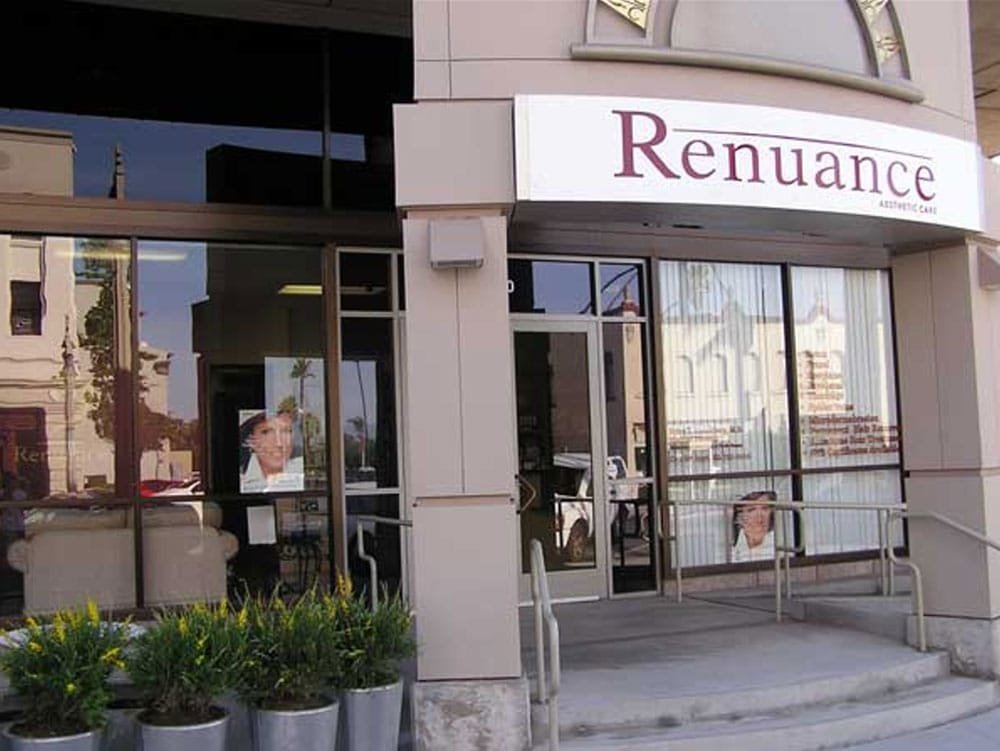
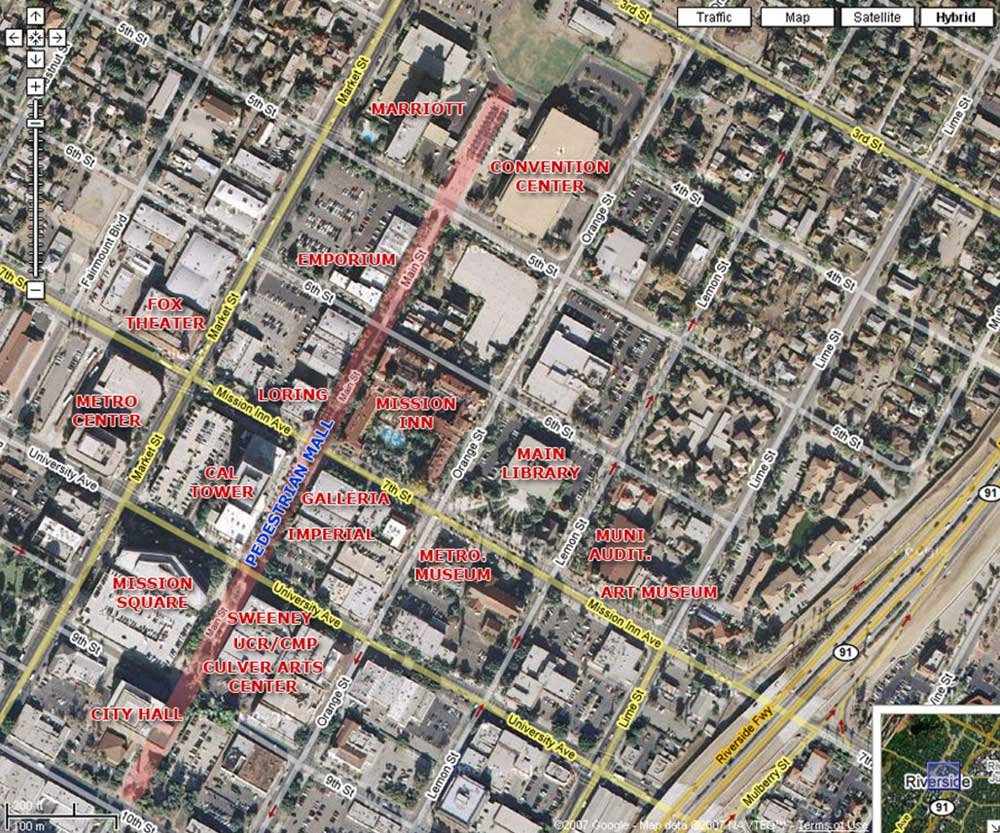
Sources: City of Riverside, Riverside Press-Enterprise, Riverside Public Library, “Colony for California” (Tom Patterson), “Riverside in Postcards” (Steve Lech), “Riverside – 1870-1940” (Steve Lech), Riverside Chambers of Commerce, New York Times, WikiPedia
2025 PAGE UPDATE: Updated/removed outdated links, including to third-party websites; updated link to Pedestrian Mall gallery; added minor context and 2025 update.
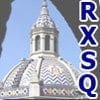
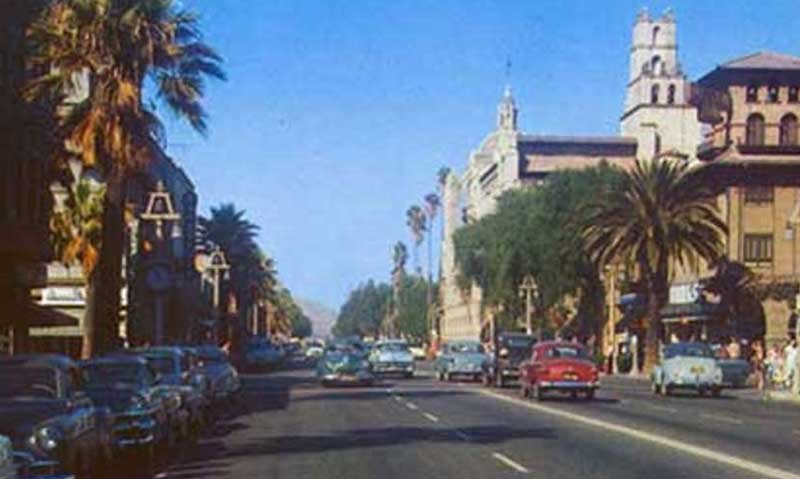
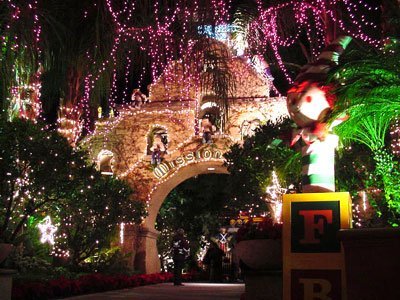
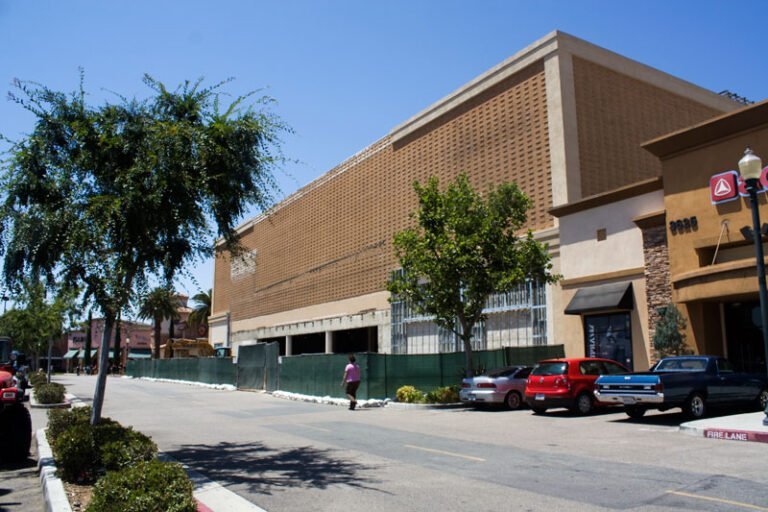
Hi,
I did email the city officials about expanding downtown mall. You can see the diagram at:
http://lightkitchen.com/downtownriverside.jpg
What I wrote:
I drew up a quick drawing which it would be easy to understand what I have been thinking about improving downtown Riverside.
See the attachment. I honestly believe the concrete slab between Marriott and Riverside Convention Center is a piece of waste. I never see anybody lounging there. It’s always empty and feels bare/cold. It should be removed at any costs. It’s a prime location which is wasted.
I believe the top parking level can be sacrificed to provide a longer extension of downtown mall which I think is excellent.
It would help inject new economic growth into downtown Riverside as you can see the drawing, it will not demolish anything significant, but rather enhance both Marriott and Riverside convention center.
Rene V.
Ward 1 resident
@Rene — We agree the “concrete slab” between the convention center and Marriott needs some help. Recently, there’s been mention of placing a military memorial/water feature near the area. Although we have yet to see any actual plans, the idea is intriguing if only because it could finally mean extending the pedestrian mall to Third Street. Regardless, any development will need to seamlessly incorporate both the Marriott and convention center into its plans.
Btw, the vacant area reaching toward Third Street was originally planned as the site for a concert hall when Raincross Square was first proposed in the early 1970s. Needless to say, the concert hall failed to get past the planning stages (mainly due to finances). The site offers unique potential, particularly in light of the mixed-use, condo developments (m sole’ and Raincross Promenade) planned for across Third Street. We feel these mixed-use developments, which by their nature are pedestrian-friendly, offer a great opportunity for expanding the pedestrian mall.
I think there are too many memorials on the Main street. I prefer art sculptures that will stimulate conversations…art pieces that speak of Riverside’s history.
I honestly think a tank on Lake Evans is hideous and having a military memorial (I don’t mean any offense — I do support the troops, but never the wars) on the main street should be relocated closer to any government buildings, not to convention center and shops. Compare 3rd Street in Santa Monica with Riverside’ main streets. Santa Monica’s 3rd street have several art pieces whereas Riverside is dotted with memorials.
Dom said in this article:
“Betro envisions a fountain leading up to a military plaza. Maybe an amphitheater behind that. His $20 million (maybe more later) vision for the north end of downtown includes three more hotels within walking distance of the convention center and a new and improved location for groups and regional associations to gather. Of the funding, $10 million is already in the budget.”
http://www.pe.com/localnews/riverside/stories/PE_News_Local_D_convention16.38d1499.html
I don’t think it’s smart to include a foundation because it’s a prime location and I do feel that extending the pedestrian mall lined with shops is a better bet because it will inject new growth. Having an amphitheater sounds great, but we already have one in Fairmount Park and also, we have a city-owned Fox Theatre. Who wants to sit outside in scorching Riverside heat? That’s the main problem with Riverside.
Regarding the convention center, it should be built upward. It should be the MOST green convention center in the nation so groups supporting carbon neutral movement will feel obliged to rent out Riverside convention center based on its “green” status.
We can compete with other convention centers with unconventional thinking, building many stories skyward instead of expanding horizontally, incorporating Spanish style features with solar panels/windows.
Glad to continue this dialogue….
@Rene — You offer insightful observations. Indeed, the existing “art” on the pedestrian mall is tilted toward memorials, which we don’t necessarily think is bad. In fact, there will soon be another tribute/memorial, this one honoring Eliza Tibbets — mother of Riverside’s original navel orange trees — which is actually long overdue.
At any rate, we agree that balance between memorials and art on the mall would be nice. Unfortunately, one abstract piece of art — the Tripod — was recently removed from its location near City Hall in order to make way for the reopening of Ninth Street through the mall itself (something we’re not 100% excited about). Maybe this lack of balance is an opportunity for the burgeoning downtown art community?
As far as the military memorial, we think the idea has merits, mainly because of the long-standing ties the city has with March Field. Although we have yet to see any formal plans, we do think a fountain — if done well — could be a good thing. If anything, with the exception of the City Hall fountain, we feel downtown is devoid of great fountains, which would be refreshing scenery on those warm summer days.
However, we’re not yet sold on this proposal being part of the pedestrian mall, especially if it ends up creating a “wall” — both literally and figuratively — at the north end of an expanded pedestrian mall. Our feeling is that the pedestrian mall should not turn a blind eye toward the pedestrian friendly, mixed-use development (Raincross Promenade) planned directly across Third Street. In fact, the mall should expand into this new development.
With regards to the Convention Center, we agree it is indeed time to expand the 31-year-old building. But just as important is the need to renovate, in particular its exterior. Although Ontario may have a newer and larger center, it doesn’t have an adjacent pedestrian mall, an authentic downtown location — or a Mission Inn. These differences are key aspects in how — and to whom — Riverside can and should market its convention center. Thus, though we do find Ontario’s center attractive and a boon to the region as a whole (and we can appreciate the logistical advantage of being near a major airport), quite frankly, we also know that with the right building, Riverside’s authentic downtown location offers better marketing advantages.
Finally, we agree with your notion that the city — and we would add residents as well — need to begin looking upward as opposed to simply outward when it comes to new downtown development. However, growing the Convention Center upward may not be a completely viable option on account of how these centers are often utilized (e.g., various sized rooms and large, high-ceiling, support-free open spaces).
Oh, and we support your idea of a “green” convention center (as well as other buildings) and believe the city needs to return to this kind of progressive thinking that it once had.
Rene:
It’s too bad you feel that way about the old water buffalo on Lake Evans. Most old timers feel a special connection to the beast because it was built at the old Food Machinery Plant just across the tracks on 14th Street. Food Machinery was the major civilian employer in Riverside during World War II the workers felt they were making a special contribution to the war effort. Not all art has to be beautiful, and not all of Riverside’s past is associated with the Mission Inn. The water buffalo’s were built here and tested in Lake Evans before they were sent overseas. In fact, rather than being removed, the monument should be resurrected and made to stand out. The last time I drove by there it looked pretty shabby.
(Pub: Oct. 19 2008)
Richard, thanks for reminding us of the connection between the tank at Fairmount Park to the former FMC plant. Indeed, the “water buffalo” played a unique role in WWII. It’s the tiny connections like these, which many residents have forgotten or simply never knew, that add substance and color to the history of Riverside.